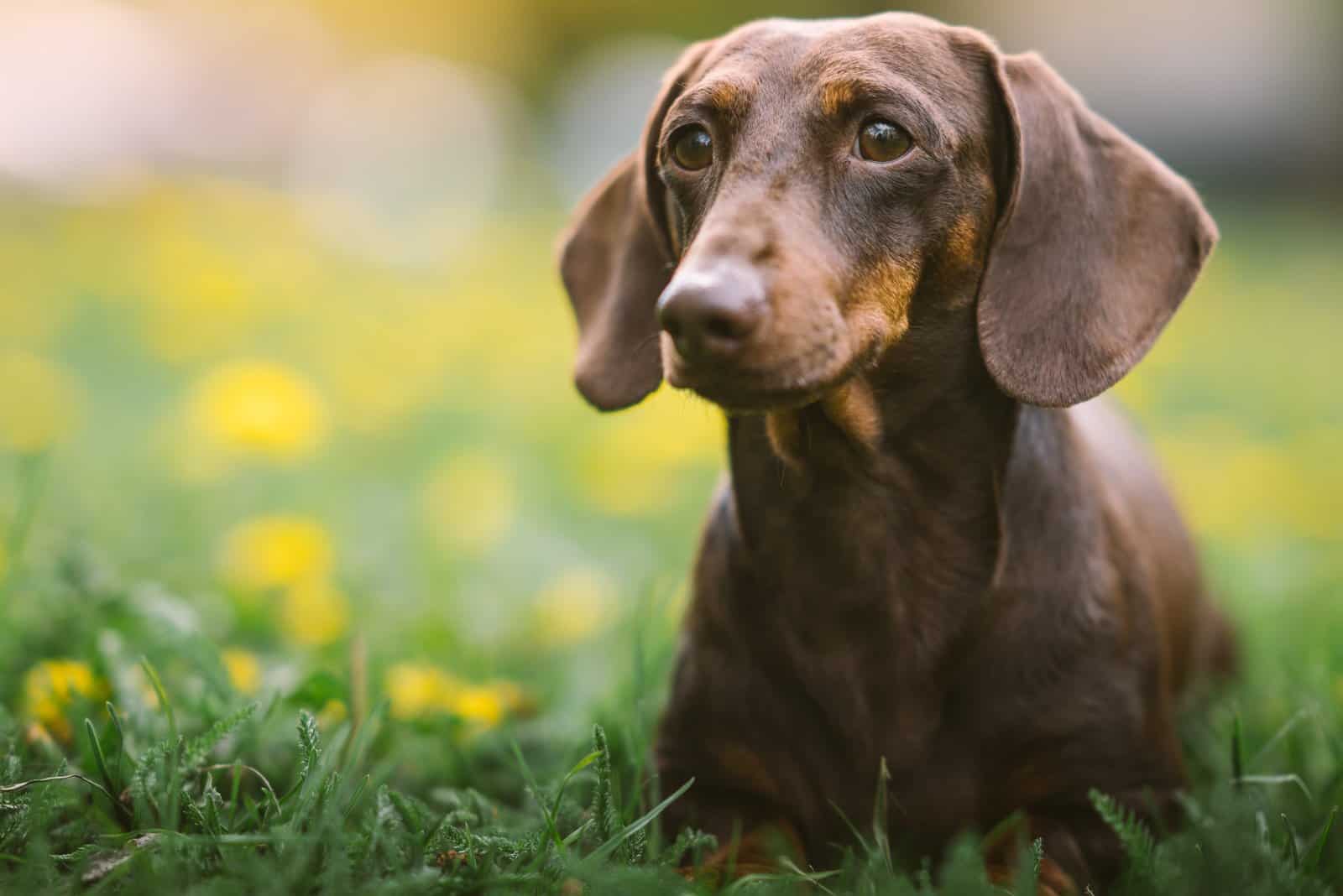The Dachshund breed is among my favorite dog breeds, and I’m very happy to tell you more about this dog’s journey from being a tiny sausage dog to becoming an adult sausage dog.
This small dog got its one-way ticket to millions of hearts of American folk. In fact, the Dachshund is nowadays ranked as the third most popular dog in the United States.
How small is this dog, or should I say, how big will the Dachshund get, lies in this Dachshund growth chart.
Our Dachshund growth chart features both Dachshund dog breed sizes – the Standard Dachshund and the Miniature Dachshund. They are both the same dog breed, only in different sizes.
The Dachshund growth chart is influenced by many external and internal factors of which we are going to talk about later in this article.
Here is everything you need to know about a Dachshund’s growth!
Dachshund Growth Chart – An Overview
In this Dachshund growth chart table, you can see the average sizes of both Miniature and Standard Dachshund puppies.
Right at the very beginning, you can clearly see differences between the puppy growth of the Miniature and the Standard Dachshund dog.
[table id=391 /]
After reading this table, you might notice that there is a small decline in growth rate after six months of age.
Keep reading to find out the reasons behind this!
Dachshund Puppy Growth Chart
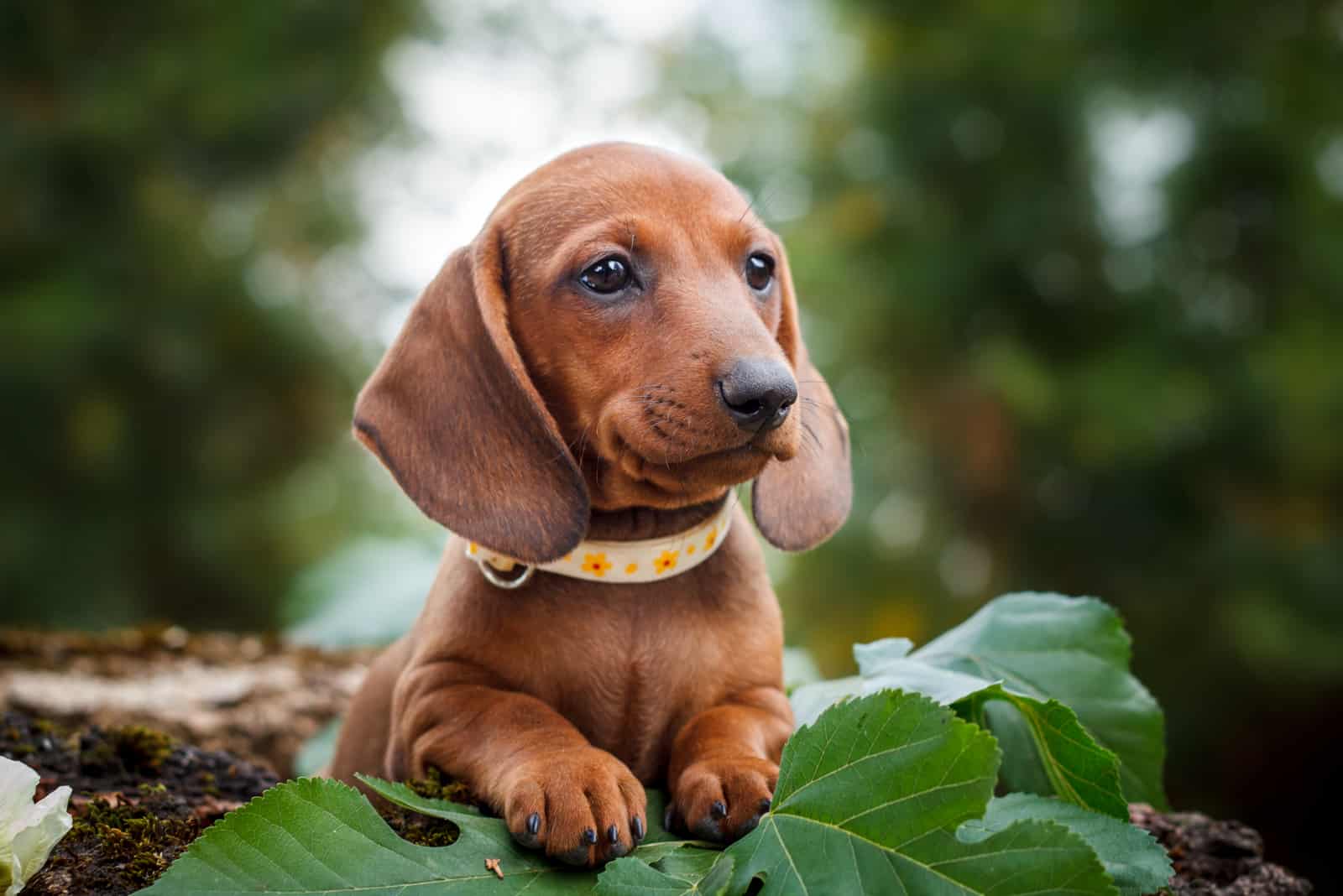
You might be surprised to find that there is little to no difference in growth and overall size between a male and a female Dachshund. That’s the reason why we didn’t specify a male Dachshund puppy and a female Dachshund puppy weight chart.
Both genders look pretty much alike. Perhaps there are certain physical traits that distinguish a female from a male Dachshund.
For example, the female dog’s head shape usually appears less bony, with finer contours. Female dogs tend to be more petite and feminine than males. But, it seems like this rule of nature isn’t followed in the Dachshund’s world.
However, there is a difference in size between a Standard and a Mini Dachshund. I mean, the name says it all anyway.
Miniature Dachshund Puppy Growth Chart
I remember my friend’s Dachshund when it was in its puppy phase. I couldn’t quite figure out if it was fully grown or if it was still a baby. Its cute puppy eyes were the main indicators that this was, in fact, a five-month old Miniature Dachshund puppy.
This made us both think, “How big should a Mini Dachshund be at five months?”
Well, to our surprise, a Miniature Dachshund weighs around eleven to thirteen pounds at five months of age. The Miniature Dachshund is by far smaller — almost half of the weight of its Standard Dachshund counterpart.
Standard Dachshund Puppy Growth Chart
There is almost no difference between the Mini Dachshund’s growth rate and the Standard Dachshund’s growth rate.
Some dog owners are surprised when they see that their Doxie has grown more than they have anticipated. But, that just goes to show that they got themselves a Standard Dachshund.
Comparison wise, a Standard Dachshund is somewhat taller and heavier than its mini version.
Its growth rate usually slows down around six months of age. In some standard Doxies, the growth rate slows down even earlier.
Dachshund Growth Stages
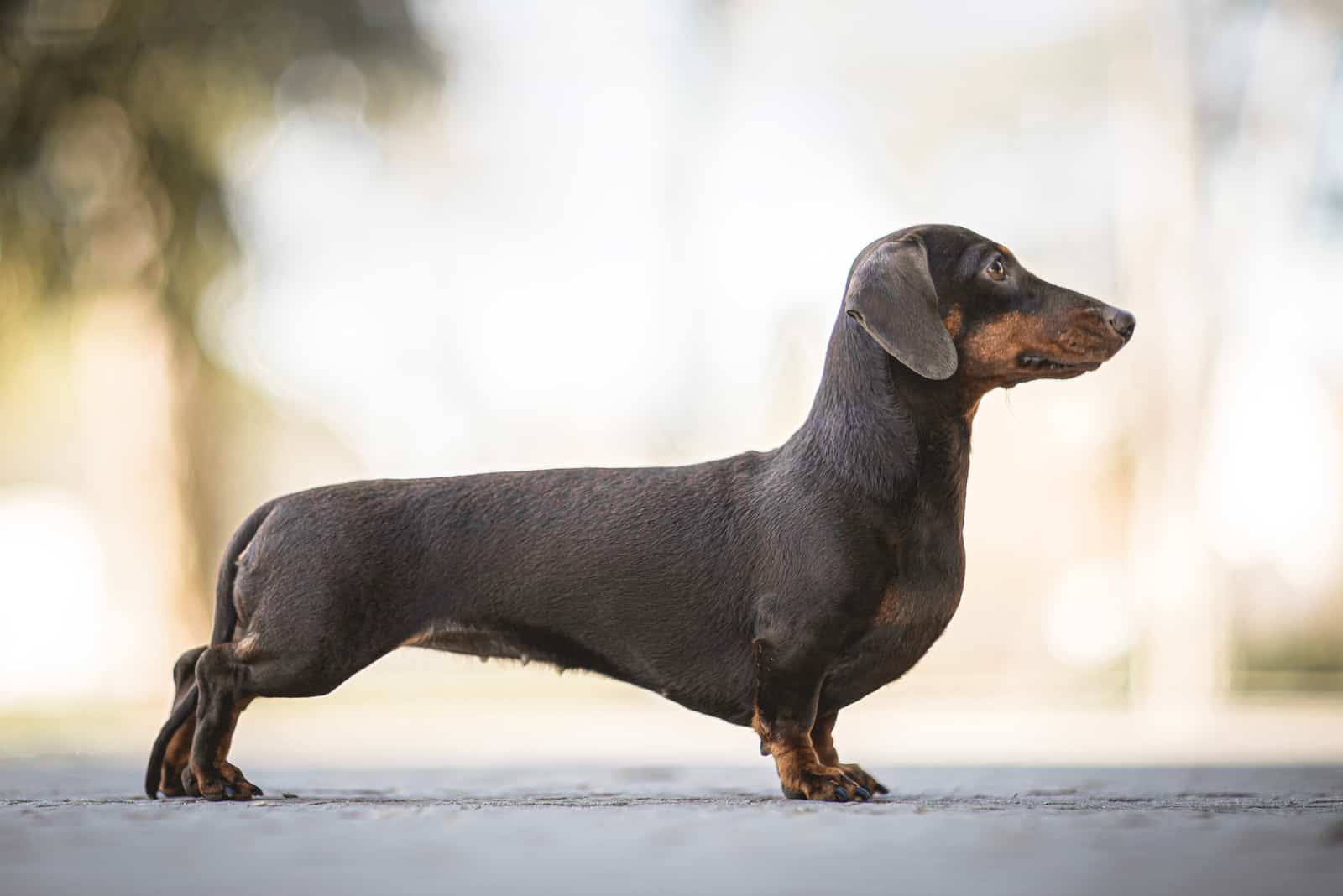
Dachshund puppies are the cutest little critters you will ever see!
Unlike large dog breeds, the Dachshund breed doesn’t go through a rapid puppy growth spurt. However there are many growth spurts recorded in their journey to becoming adults.
Let’s follow all the developmental stages of a Dachshund puppy!
Birth – Four Weeks
When Dachshund puppies are born, you can’t immediately see their characteristic sausage-body type. This is because they are just the tiniest pups that way; only two to three ounces at birth.
During the first two weeks of age, Dachshund puppies are dependent on their Mom. They always have to be by her side. In fact, the puppies must be near their mother during the whole first six weeks of age.
This is why most reputable Dachshund breeders advise selling pups when they are at least eight weeks old.
If you are expecting a long-haired Dachshund pup in the litter, you can recognize it by its feathery, fluffy coating around its legs and ears.
Eight Weeks Of Age
By the end of seven to eight weeks of age, Dachshund puppies will stop nursing. Some of their little teeth start protruding, while some are already grown.
During this period, you will know these puppies are pretty much starting to get by on their own, or at least they are trying to.
What I like about this developmental stage of a Dachshund puppy is that you get to see each puppy acquiring a unique personality.
At eight months of age, Dachshund puppies are the most fun to be around. They’re loud, clumsy, fast, cheerful, and happy. It’s just so amazing watching these small puppies meet the world around them.
You can often see them interacting with one another — licking each other’s ears, engaging in rough play, and even barking for no particular reason! I mean they are probably just learning how to use their tiny voices, right?
This is the perfect time to start with early socialization. However, don’t expect your Doxie puppy to immediately cooperate. Dachshund socialization might take some time, but it will pay off in the long run!
As Aristotle once said, “Patience is bitter, but its fruit is sweet.”
Four Months

Your Doxie puppy has grown quite a lot, hasn’t it?
By four months of age, the dachshund puppy will weigh nine to eighteen pounds (depending on the Mini and the Standard size).
Around this time, the Dachshund puppies’ zoomies are hard to calm down. These energetic pooches are crazy for some quality playtime!
But, by four months of age, you will want to already have socialized your Dachshund puppy. Due to the unique nature of this dog, early socialization is crucial.
The Dachshund puppy might act quite stubborn and independent. At times, their stubbornness can come out as aggressive behavior. Although fixing a dog’s aggressive behavior is possible, it’s still best to prevent it with early socialization.
Six Months
Let’s get to six months of age, which marks the half-year birthday of your Dachshund puppy. We’re almost halfway to its full size!
Now, here is the really interesting thing about the Dachshund dog breed. At six months old, this dog looks almost like an adult dog. This isn’t usually seen in other dog breeds.
The Dachshund pup hasn’t stopped growing either physically or mentally. Especially mentally – this dog is nowhere near its adulthood. I mean, these dogs stay small even when they reach their adult size.
By six months of age, you will notice quite some changes in your Dachshund puppy’s body. Its remarkable physical traits resemble those of the adult-size Dachshund. Its legs are short and its body is long — that’s what we want to see!
What’s really cool is that the Dachshund’s coat color may start to change to darker hues between six and eighteen months of age!
At What Age Are Dachshunds Fully Grown?

Their growth rate slows down between six and eight months of age.
Dachshunds are fully grown at eight months of age. But, that doesn’t necessarily mean that these dogs sexually mature at the same time they reach their full size.
That said, Dachshunds can reach sexual maturity anywhere between six and twelve months of age.
Each dog is unique, so some Doxies will reach sexual maturity at eight, some at twelve, and some even at sixteen months of age.
Before it reaches sexual maturity, the male Dachshund puppy might show signs that it wants to mate. This is usually the first sign to dog owners that their puppy is fully grown.
How Big Is A Full-Size Dachshund?
The American Kennel Club (AKC) has put up some official breed standards for our badger dog. These standards state that a Standard Dachshund weighs anywhere from 16 to 32 pounds. The height of a Standard Dachshund is therefore eight to nine inches.
As for Miniature Dachshunds, these little guys weigh up to eleven pounds, and they stand five to six inches tall… or should I say, short!
How To Weigh Your Dachshund
Weighing your Dachshund puppy is very easy. You can use your own weighing scale that you have lying around the house! But, do keep in mind that human scales are made for heavier weights. I mean, we humans definitely weigh more than little Dachshunds.
So, what I want to say is that your weighing scale may not be as precise as an animal weighing scale.
Therefore, if you are curious about how much your Dachshund weighs, I would advise you to go to your vet’s clinic. Animal weight scales at the veterinary clinic are very precise because veterinarians need to know the exact dog’s weight in order to properly administer medication.
If your Doxie is a teeny tiny puppy, you can also use a kitchen scale. Simply place your little Doxie in a bowl and measure its weight with help from a precise kitchen scale.
Dachshund Puppy Weight Calculator
Another thing that you can do, especially if you’re good at math, is to use a puppy weight mathematical formula to estimate your Dachshund’s weight chart. So, here is what you want to do:
First, you will want to know your Dachshund puppy’s weight at a certain month of age. Then, take that puppy weight and divide it by its age in weeks.
Here’s an example: your dachshund puppy weighs nine lbs at four months of age. You want to divide nine by 16. Next thing you want to do is multiply the result by 52. Why 52, you may ask? Well, 52 is the number of weeks in a year.
Ta-da! You just estimated your Dachshund puppy’s growth!
Of course, there is a shortcut to all of this. Difficult math assignments in the Dachshund weight chart can be skipped, thanks to online weight calculators.
These calculators work on the same principle. But, they are a bit more specific because they take into consideration your dog’s breed and age.
What Is The Maximum Height Of A Dachshund?
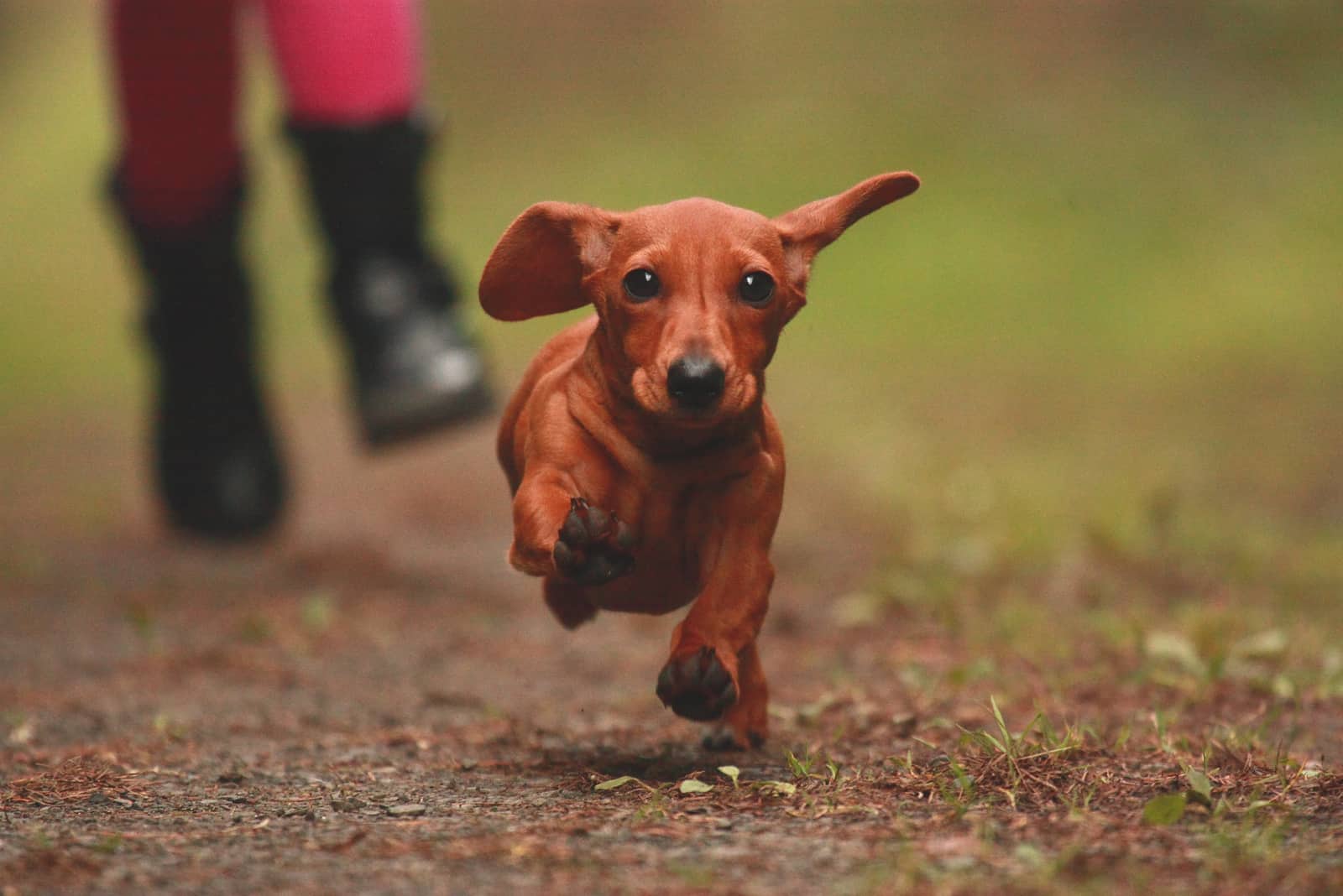
Firstly, the height of your Dachshund puppy depends on whether it’s a Standard Dachshund or a Miniature Dachshund.
After it has reached its full size, and you have measured its height to be somewhere between five and nine inches, it’s likely that you have a Miniature Dachshund by your side.
On the other hand, if your Doxie grows up to be ten to twelve inches in height, then you are dealing with a Standard Dachshund.
How To Measure Your Dachshund
If you are unsure whether your Doxie is a Standard or a Mini Dachshund, you will want to measure its height.
Normally, measuring a Dachshund’s height is done when the dog reaches its full size. The correct way to measure your Doxie is somewhat similar to how humans measure their height.
Start by simply taking your trusty measuring tape. You will want your Doxie placed in a standing position. But, if its zoomies have just kicked in and you can’t get it to stand still, you might as well leave dog measuring for another day.
However, if your Doxie is a good boy, and is patiently standing, you can start measuring it. Place your measuring tape on the floor near your Dachshund’s paws, and extend it up to its withers – A.K.A, its shoulder blades.
Voila! You just measured the height of your little Doxie.
How Long Should A Dachshund Puppy’s Body Be?
The Dachshund breed is known for its long body. So, of course, there are more inches in its body length than in its body height.
To be more specific, a Standard Dachshund can be anywhere between 21 and 26 inches long. These numbers derive from measuring your Dachshund puppy from the base of its tail to its nose.
But, when you measure a Dachshund from the root of the tail to its neck, then the measured body length should be around 17 to 18 inches.
I mean, they were originally bred to have long bodies, so this is nothing to be surprised about. Dachshunds are natural hunters, and such long bodies help them burrow in order to find badgers and other prey.
The Dachshund’s body length depends on the breeder and the parent dog’s genetics. Some dogs can be longer, and some can be shorter. The Miniature Dachshund is smaller in size, so expect its body length to also be shorter.
You might notice that many Dachshund mixed breeds have different body types – some not resembling the long Doxie body. Well, this all depends on the other dog breed that a Dachshund has been crossed with. A mixed breed’s appearance is usually a doggie lottery. You never know what you’ll get!
Is My Dachshund Puppy Underweight?

If you have correctly weighed your Dachshund puppy, but something seems off — you may think that your Doxie is underweight.
First, ask yourself what kind of dog food you are giving your Dachshund puppy. When Dachshund puppies transition from their mother’s milk, high-quality puppy kibble should be your first choice of dog food.
In addition to healthy dog food, you should provide your Doxie with regular quality playtime and training. Their short legs could use some running!
Physical exercise helps dogs build proper muscle mass and healthy weight gain. In dogs like the Dachshund, a strong muscle foundation is crucial for normal bone development and function.
If you are still uncertain about your dog’s weight, you can opt for a calorie count with each meal. Make sure that your dog’s meal is packed with animal protein, healthy fats, and calories.
The average weight of a Standard Dachshund is around 30 to 32 pounds. On the other hand, the average adult weight of a Miniature Dachshund is between 15 and 17 pounds.
So, the ideal weight of your Dachshund should be within this range.
Whether your Doxie is a standard or a miniature, a healthy weight is reflected through great physical appearance.
Can Neutering/Spaying Affect My Dachshund Puppy’s Growth?

The short answer is yes and no. You might be wondering why I’m saying yes and no at the same time, but let me explain.
You probably already know that neutering is a surgical procedure carried out by a licensed veterinarian. Neutering refers to the removal of the testicles from a male dog. Opposed to neutering, spaying is done to remove the uterus and ovaries from female dogs.
So, a Dachshund without testicles, or one without ovaries, won’t have sufficient testosterone, or estrogen hormones, after neutering/spaying.
Now, this is not a big deal if neutering/spaying is done at the right time. But, when a male Dachshund puppy is neutered before the appropriate age of eight months, it will most likely have problems with physical development.
Female Dachshund puppies should be spayed between six and twelve months of age. If done too early, female Doxies can also have troublesome puppy growth.
So, yes, neutering can affect your male puppy’s growth if done too early. In contrast to that, neutering/spaying is beneficial when done at the right time. It reduces risks of testicular and uterine cancer, and it also aids in preventing naughty Dachshund behavior.
Common Dachshund Health Issues
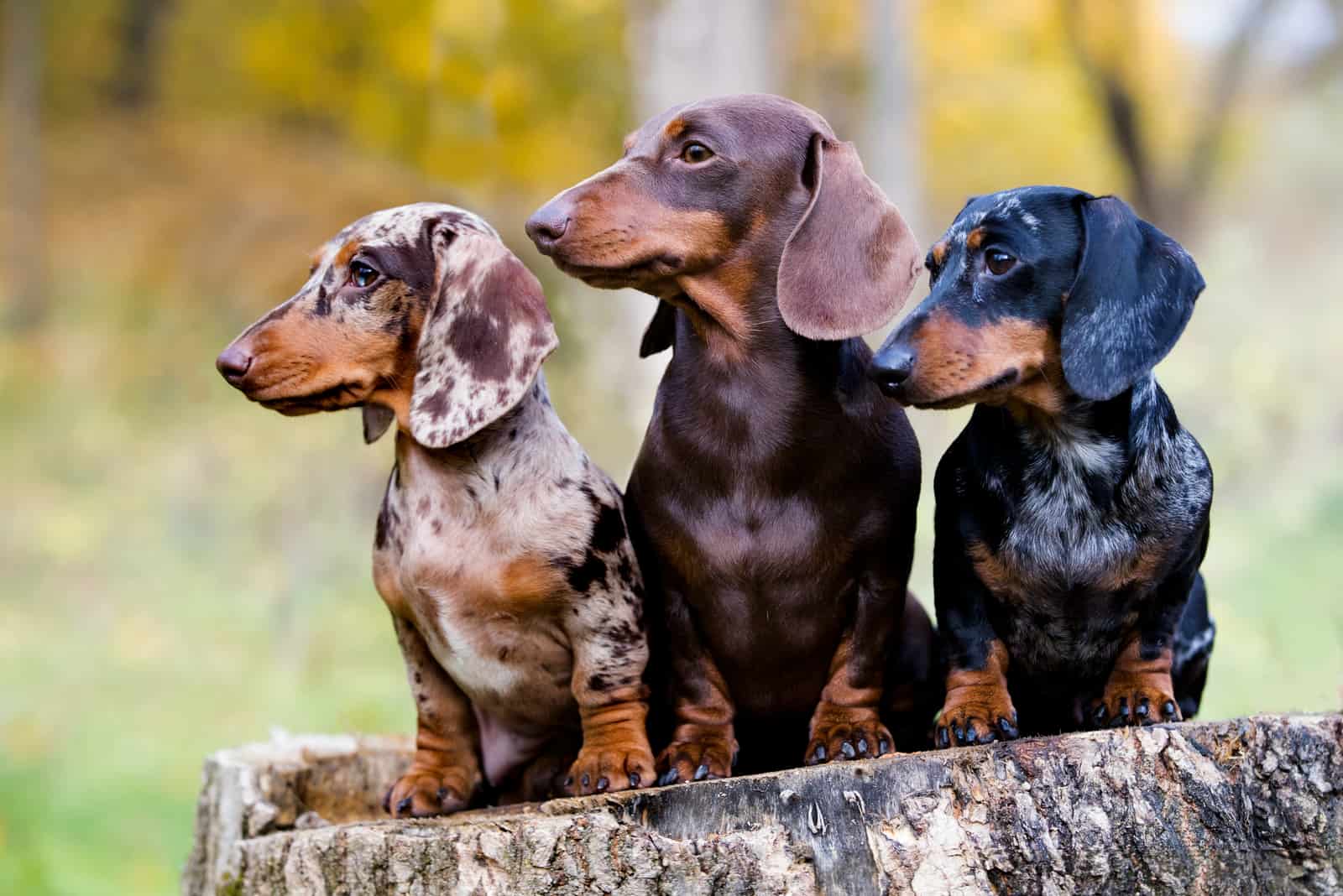
Uopn the first glance of this purebred dog, I felt kind of skeptical about its health condition. Turns out that the Dachshund dog breed isn’t as healthy as I thought it was. Although this made me very sad, it also made me learn more about the Dachshund’s health issues.
Most health issues in Dachshunds are linked to their small size. It’s no surprise that their dwarf anatomy results in breed-specific diseases.
To my consternation, the Dachshund’s bones are not yet developed when this puppy reaches twelve months of age. To be more precise, the growth plates within a Doxie’s bones do not close until they are 12 months old. This is what plays a huge role in the Dachshund growth chart.
The first year of life is the most important for every dog, especially for our little Dachshund. Your dog’s health is very important, so it’s essential to know about the following health conditions.
Rickets
Since a Dachshund’s bones take longer to develop, they require all the nutrients and vitamins for normal physiological growth. If Dachshund puppies fail to receive vitamins and minerals, this can lead to skeletal problems.
One of the main skeletal problems in Dachshund puppies is rickets. Rickets in dogs causes their bones to soften, which results in abnormal appearance. You may have even seen a Dachshund with its forelimbs pointed outward.
Fortunately, rickets is fixable — only if the therapy starts at the right time. Treating a Dachshund puppy with rickets must be done with the help of your veterinarian.
Dietary supplements as well as proper physical activity may reduce the signs of rickets.
Obesity
In addition to weak bones, improper diet can lead to premature obesity. Believe it or not, not only are old Dachshund dogs prone to obesity, but Dachshund puppies can also suffer from this health problem.
A Dachshund puppy can become obese if an irresponsible dog owner isn’t feeding it high-quality dog food or if the dog owner is giving one too many treats. Although some might think that fat Dachshunds look funny, they certainly don’t feel funny.
Obesity is a very serious problem that affects the Dachshund breed, and it’s quite common, too. Trust me, your Doxie is allowed to miss a meal or two. Don’t overfeed it.
Dog obesity carries many secondary health issues like hypothyroidism, diabetes, heart diseases, and liver diseases.
Another thing to have in mind is how much weight its short legs have to endure when a Dachshund is overweight.
Spine Problems
A Dachshund’s elongated body isn’t doing it much favor. A heavy Dachshund belly can weigh down its body, causing problems in its spine. And, you don’t want your Dachshund puppy’s back to hurt.
A common health condition in Dachshunds is Intervertebral Disc Disease (IVDD). This health issue is a known, congenital, breed-specific issue in the Dachshund breed.
Intervertebral disc disease in dogs is a serious health problem as it can affect the whole spine. As the name suggests, cartilage discs that are placed between the dog’s vertebrae become damaged. This may result from spinal trauma or it may develop by itself.
Despite injuries, the only culprit for IVDD is the Dachshund’s genetics and its long body with short legs.
Before you say that there is no way that your Doxie could suffer from this disease, I just want to let you know that one in five Doxies inherits IVDD. Researchers are still working on DNA testing for IVDD in dogs. Most Dachshund dog breeders cannot guarantee that their Doxies will be IVDD clear.
How Long Do Dachshunds Live?
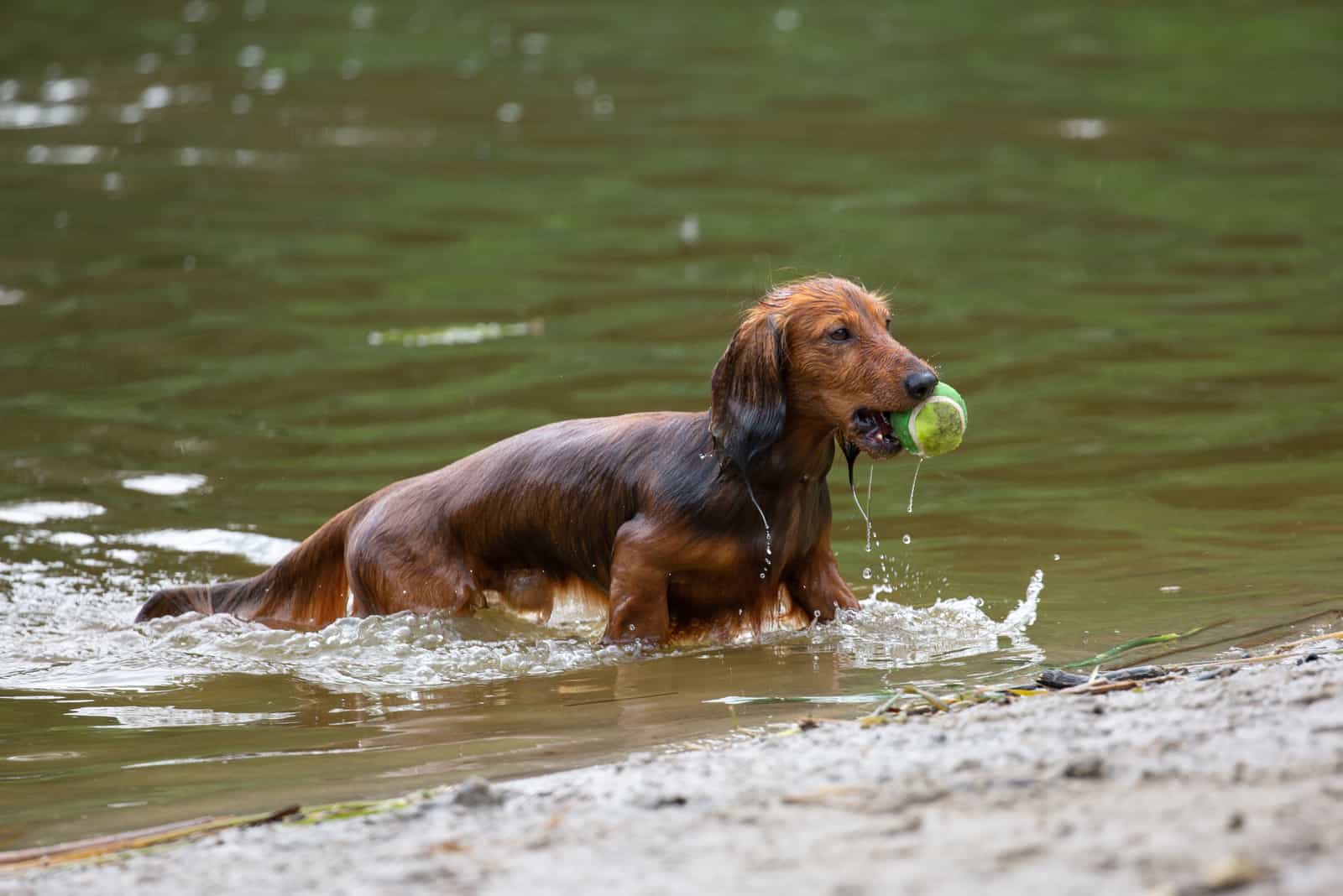
A Dachshund’s life expectancy is between 12 and 16 years.
Although this badger dog might be prone to certain breed-specific health issues, it can live quite a long time.
Surprisingly, its unique puppy growth and body structure doesn’t affect the Dachshund’s lifespan. In other words, its physique may cause a Dachshund certain health problems, but it doesn’t cut its life expectancy too short.
Doxies are small dogs. And, we all know that small dogs like Beagles, Chihuahuas, and Shih Tzus have a longer lifespan than large dogs.
A Dachshund’s lifespan is influenced by its quality of life. This means that the life expectancy of a Dachshund pup will depend on how you treat it from day one.
The healthier the Doxie, the longer its lifespan!
Let’s Wrap It Up
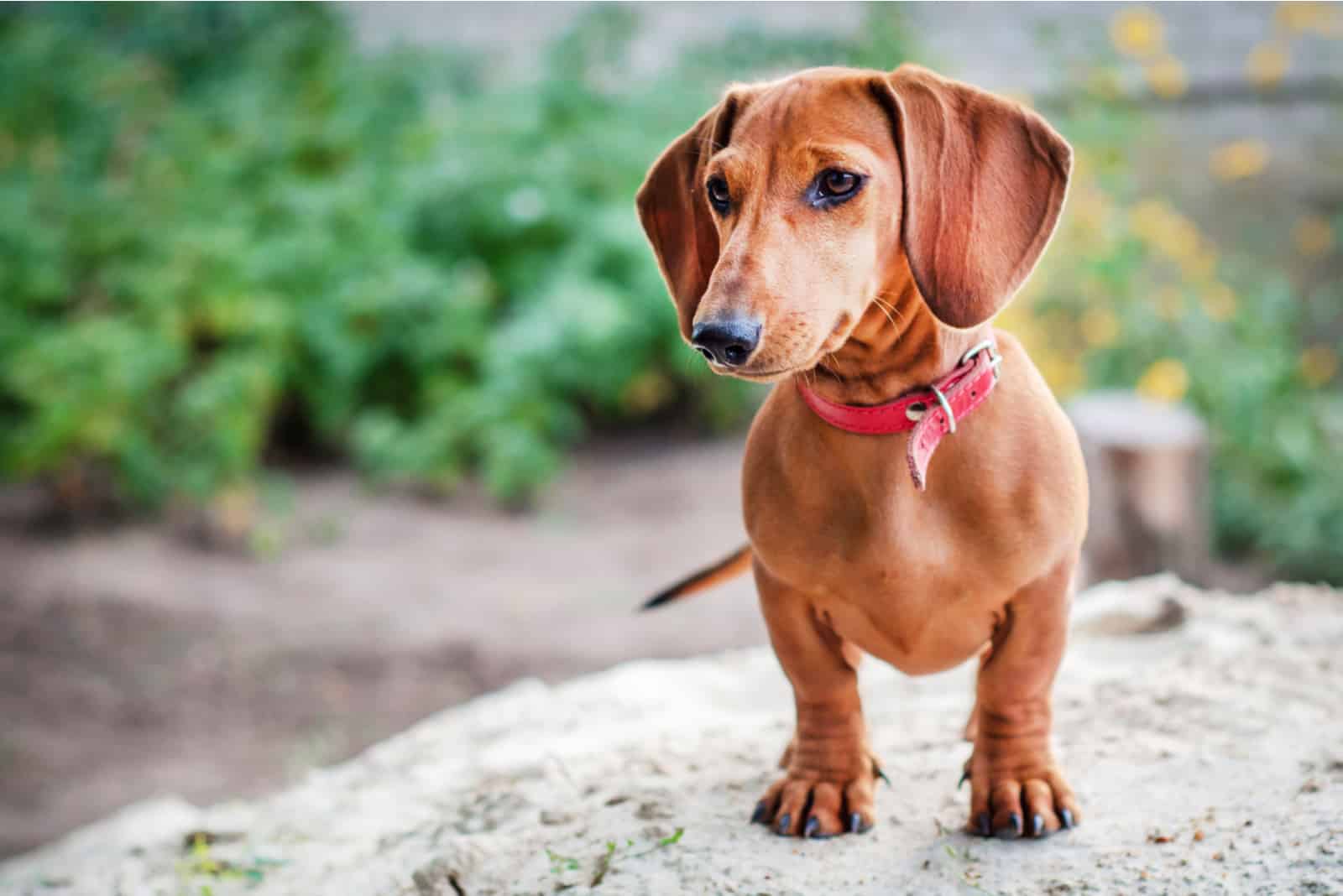
Despite the Dachshund’s small size, its personality is over the roof! When getting a Dachshund puppy, you are getting a small dog with a huge personality.
And, it’s just thanks to their sweet personality that their popularity has risen a lot during the past few years.
Being such a small dog, its compact body makes it a great living companion for dog lovers who live in smaller apartments.
Hopefully, this Dachshund growth chart will help you estimate your new Doxie’s weight and size!
Keep in mind that this small dog is a fierce hunter, so life in an apartment might not be enough for it. Doxies are needy, and they don’t like to be left alone, so make sure to provide your pup with extra attention!
Related Content
• Cocker Spaniel Growth Chart: How Big Will This Puppy Get?
• German Shepherd Growth Chart – How Big Your GSD Puppy Will Be
